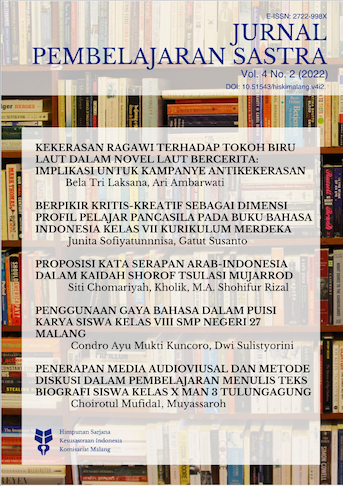PENERAPAN MEDIA AUDIOVIUSAL DAN METODE DISKUSI DALAM PEMBELAJARAN MENULIS TEKS BIOGRAFI SISWA KELAS X MAN 3 TULUNGAGUNG
##plugins.themes.academic_pro.article.main##
Abstract
Media and learning strategies encompass all aspects of lesson preparation and assessment, including assessment tools. Students have an easier time absorbing and making sense of course content when suitable media and methods are used. At MAN 3 Tulungagung, one of the Indonesian language instructors makes good use of various media and techniques to ensure that her students learn the language. The Indonesian language instructors at MAN 3 Tulungagung rely on audiovisual materials and classroom discussion to teach their students the language. It is believed that by using these media and methods, a pleasant and non-saturating learning environment will be created, which will improve the learning quality and student values, particularly when it comes to learning to write biography texts. Due to the prevalence of this issue, academics are keen to delve further into the topic of learning device selection, particularly as it pertains to the use of audiovisual media and discussion techniques. The study falls under the category of qualitative research. An X class MAN 3 Bone student is the object of this investigation. The audiovisual medium and discussion techniques are the objects of his research. The three main methods used to collect data in qualitative research are interviews, observations, and documentation. This study's analysis consists of data processing, data presentation, and conclusion drawing. It is clear from the data analysis that the Indonesian MAN 3 Tulungagung teacher can effectively use AV materials and discussion techniques to help her students learn to write biographies. Planning, executing, and evaluating are the three phases of this method's application to media.
##plugins.themes.academic_pro.article.details##

This work is licensed under a Creative Commons Attribution-NonCommercial-NoDerivatives 4.0 International License.
The Authors submitting a manuscript do so on the understanding that if accepted for publication, copyright of the article shall be assigned to Jurnal Pembelajaran Sastra (Journal of Literary Education) as publisher of the journal, and the author also holds the copyright without restriction.
Copyright encompasses exclusive rights to reproduce and deliver the article in all form and media, including reprints, photographs, microfilms and any other similar reproductions, as well as translations. The reproduction of any part of this journal, its storage in databases and its transmission by any form or media, such as electronic, electrostatic and mechanical copies, photocopies, recordings, magnetic media, etc. , are allowed with a written permission from Jurnal Pembelajaran Sastra (Journal of Literary Education).
Jurnal Pembelajaran Sastra (Journal of Literary Education), the Editors and the Advisory International Editorial Board make every effort to ensure that no wrong or misleading data, opinions or statements be published in the journal. In any way, the contents of the articles and advertisements published in the Jurnal Pembelajaran Sastra (Journal of Literary Education) are sole and exclusive responsibility of their respective authors and advertisers.

